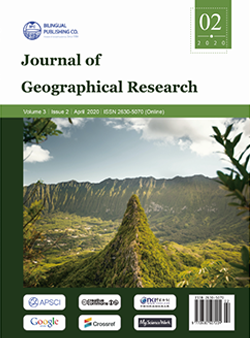-
11162
-
1915
-
1843
-
1704
-
1391
Gray Water Measurement and Feasibility of Retrieval Using Innovative Technology and Application in Water Resources Management in Isfahan-Iran
DOI:
https://doi.org/10.30564/jgr.v3i2.1997Abstract
Reuse of wastewater for agriculture and green spaces purposes is significant. A mean yearly precipitation in Esfahan is 150 mm. The drinking water and agriculture usually used underground resources in the city. Gray water recycling is known as a suitable option today. Delivering all the water requirements of a home from refined water rises the cost of water. Whereas the essential water quality for garden, toilet and irrigation is less than drinking water. Therefore, the aim of this study is to analyze the evaluation of gray water and estimate the amount of recycle gray water which can use for drinking water with innovation method in Esfahan region in Iran. Previous studies did not measure the value of recycling gray water with new method of waste water treatment that can use for drinking purpose. In this study,gray water in Esfahan city is measured and technical aspects of its recycling is examined. Because of the lack of referable guidelines and official technical reports, studies from other similar countries applied in this study and on the basis of which the amount of recoverable gray water was calculated.Evaluations indicates that the overall recovery of gray water in Esfahan saves nine million cubic meters of water. The price of the rial of this value established on water is 190 billion Rials. Given the lack of water sources in Esfahan, the recycle of gray water seems to be a good option, however more research is required to select a recovery strategy.Keywords:
Gray water, Sustainable water management, New technology, Reuse of gray waterReferences
[1] Huelgas-Orbecido, A., Funamizu, N.. Membrane System for Gray Water. In Resource-Oriented Agro-sanitation Systems. Springer, Tokyo, 2019:185-193.
[2] Al-Ghazawi, Z., Qasaimeh, A., & Bani-Melhem,K.. Ablution gray water qualitative assessment and treatment by submerged membrane bioreactor: a case study in Jordan. Desalination and Water Treatment, 2018, 127: 213-221.
[3] Al-Gheethi, A. A. S., Noman, E. A., Mohamed, R. M.S. R., Talip, B. A., Abdullah, A. H., Kassim,A. H. M..Reuse of Greywater for Irrigation Purpose. In Management of Greywater in Developing Countries.Springer, Cham, 2019: 73-87.
[4] Shafiquzzaman, M., Haider, H., AlSaleem, S. S.,Ghumman, A. R., Sadiq, R.. Development of Consumer Perception Index for assessing greywater reuse potential in arid environments. Water SA,2018,44(4): 771-781.
[5] Beler-Baykal, B.. An Appraisal of Domestic Wastewater Segregation from the Perspective of Recovery,Recycling, and Reuse. In Recycling and Reuse Approaches for Better Sustainability.Springer, Cham,2019: 11-20.
[6] Manna, S.. Treatment of Gray Water for Reusing in Non-potable Purpose to Conserve Water in India. International Journal of Applied Environmental Sciences, 2018, 13(8): 703-716.
[7] Prodanovic, V., Hatt, B., McCarthy, D., Zhang, K.,Deletic, A.. Green walls for greywater reuse:Understanding the role of media on pollutant removal. Ecological Engineering, 2018, 102:625-635.
[8] Javadinejad, S., Hannah, D., Ostad-Ali-Askari, K.,Krause, S., Zalewski, M., Boogaard, F.. The Impact of Future Climate Change and Human Activities on Hydro-climatological Drought, Analysis and Projections: Using CMIP5 Climate Model Simulations. Water Conservation Science and Engineering, 2019,4(2-3): 71-88.
[9] Busgang, A., Friedler, E., Gilboa, Y., Gross, A..Quantitative Microbial Risk Analysis for Various Bacterial Exposure Scenarios Involving Greywater Reuse for Irrigation. Water, 2018, 10(4): 413.
[10] Juan, Y. K., Chen, Y., Lin, J. M.. Greywater reuse system design and economic analysis for residential buildings in Taiwan. Water, 2016, 8(11): 546.
[11] Al-Kalbani, M. S., Price, M. F., Ahmed, M., Abahussain, A., O’higgins, T.. Environmental quality assessment of groundwater resources in Al Jabal Al Akhdar, Sultanate of Oman. Applied Water Science, 2017, 7(7): 3539-3552.
[12] Zha, X., Ma, J., Lu, X.. Performance of a coupling device combined energy-efficient rotating biological contactors with anoxic filter for low-strength rural wastewater treatment. Journal of Cleaner Production,2018, 196: 1106-1115.
[13] Mishra, V., Abrol, G. S., Dubey, N.. Sodium and Calcium Hypochlorite as Postharvest Disinfectants for Fruits and Vegetables. In Postharvest Disinfection of Fruits and Vegetables. Academic Press, 2018: 253-272.
[14] De Gisi, S., Casella, P., Notarnicola, M., Farina, R..Grey water in buildings: a mini-review of guidelines,technologies and case studies. Civil Engineering and Environmental Systems, 2016, 33(1):35-54.
[15] Sumisha, A., Arthanareeswaran, G., Thuyavan, Y. L.,Ismail, A. F., Chakraborty, S.. Treatment of laundry wastewater using polyethersulfone/polyvinylpyrollidone ultrafiltration membranes.Ecotoxicology and environmental safety, 2015, 121: 174-179.
[16] Hou, L., Hu, B. X., He, M., Xu, X., Zhang, W.. Effect of intermittent operation model on the function of soil infiltration system. Environmental Science and Pollution Research, 2018, 25(10):9615-9625.
[17] Ali, A., Ahmed, A., Gad, A.. Chemical and microstructural analyses for heavy metals removal from water media by ceramic membrane filtration. Water Science and Technology. 2016, 75(2):439-50.
[18] Jeong, H., Broesicke, O. A., Drew, B., Crittenden, J.C.. Life cycle assessment of small-scale greywater reclamation systems combined with conventional centralized water systems for the City of Atlanta,Georgia. Journal of Cleaner Production, 2018, 174:333-342.
[19] Blanky, M., Rodríguez-Martínez, S., Halpern, M.,Friedler, E.. Legionella pneumophila: from potable water to treated greywater; quantification and removal during treatment. Science of the Total Environment, 2015, 533: 557-565.
[20] Walter, X. A., Merino-Jiménez, I., Greenman, J.,Ieropoulos, I.. PEE POWER® urinal II–Urinal scaleup with microbial fuel cell scale-down for improved.
Downloads
How to Cite
Issue
Article Type
License
Copyright © 2020 Safieh Javadinejad Javadinejad, Rebwar Dara, Forough Jafary

This is an open access article under the Creative Commons Attribution-NonCommercial 4.0 International (CC BY-NC 4.0) License.




 Safieh Javadinejad
Safieh Javadinejad





